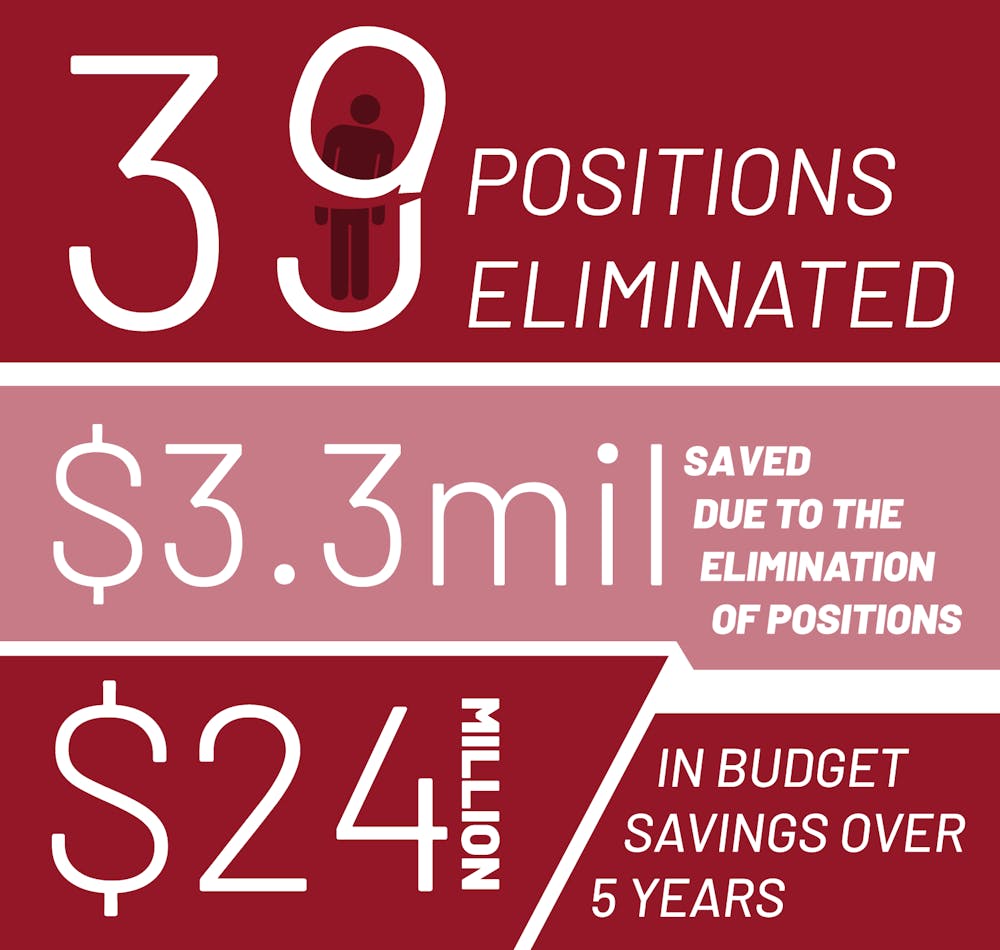Almost two weeks ago, Miami University announced the elimination of 39 staff positions across all campuses due to budget reallocations. This isn’t the first time measures like this have been taken.
Following the stock market crash in September 2008, Miami announced a plan to cut $16 million across all divisions, asking each division to devise its own plan to cut costs. As a way to reduce spending, the university put a hiring freeze on staff positions and reduced the amount of searches to fill open faculty positions.
In February 2009, Miami began the first in a series of staff position eliminations, as University President David Hodge emailed staff members that 64 positions would be eliminated. This included 10 employees of Miami's former public radio station, WMUB. The station contracted out to Cincinnati Public Radio as a way to cut back on expenses during the budget cuts.
In October 2009, 33 additional positions were eliminated. In early 2010s, the university went through more rounds of employee lay-offs following low enrollment in the first-year class and budget cuts from the state.
During these budget cuts, Hodge held forums to discuss the university’s financial situation. In total, the university saved $64.5 million from budget reductions and a lack of salary increases, said David Creamer, senior vice president for finance and business services, who started at Miami in June 2008. In total, the university had 420 less employees in 2011 than in 2008. This includes layoffs, retirements or those leaving the university for other reasons.
The majority of the positions cut from 2009-2011 were never re-filled. The university has around 300 fewer employees now compared to 2008.
“In my opinion, Miami responded very well to the Great Recession,” economics professor Mike Curme wrote in an email to The Miami Student. “Tough decisions were made in a timely fashion and in a manner considerate of our mission.”
Although Miami spent years cutting the budget after the stock market crash, Creamer thinks the university is in a better place financially.
“I think we’ve recovered well,” Creamer said. “We’ve developed ways for how we manage things … I think given the growth and demand for our programs, the things that we were able to do to enhance services for students suggests that we made many good choices.”
Creamer said the university doesn’t really think back to the recession in terms of finances but rather focuses on preparing for the future.
Carolyn Hardin, an American studies and media and culture professor who researches the economy, agreed with this sentiment and said Miami is doing well financially compared to other universities.
This fall, Miami welcomed its largest first-year class ever of 4300 students. This isn’t true of all universities, though. According to Forbes, in 2019 postsecondary enrollments decreased by 1.3 percent, a trend that has been continuing for the last decade.
Enjoy what you're reading?
Signup for our newsletter
“Miami has to face that reality,” Hardin said, referring to the state of higher education. “We’re in a higher education recession right now.”
Moody’s Investor’s Service, a site that ranks colleges based on economic outlook, labeled Miami as “stable” in 2019, the second-highest rating a university can earn.
Creamer said one difference between Miami’s economic planning now and a decade ago is that the university currently creates budget plans for five or ten years in the future, trying to anticipate changes before they occur. Previously, the university only planned one or two years in advance.
It’s impossible to fully predict the future, though, which leads to changes in the plan — like the current acceleration of budget cuts.
“[The plan is] going to change; that’s the only thing that I can guarantee,” Creamer said. “When you try to estimate the future, you have to accept the fact that you’re going to be wrong.”
The university originally hoped to avoid layoffs and to eliminate positions through attrition, meaning not filling positions opened up through employees resigning, retiring or leaving the university.
However, Miami currently faces budgetary challenges due to the lower number of students graduating high school and the drop in applications of international students from China, Creamer said.
This resulted in the elimination of 137 total staff positions, including 39 layoffs and 98 positions opened through attrition. Creamer said whenever a position opens through a resignation or retirement, the university evaluates whether it needs to fill that position. The 39 employees whose positions are being eliminated will serve in their current roles until July 1.
Looking to the future, Creamer said Miami will make decisions based on how large and drastic of a budgetary impact the university is facing. He said the university would evaluate its options at that time but didn’t say that future layoffs are out of the question.




